Previous issues
- Page Path
- HOME > Browse Articles > Previous issues
- [English]
- Fabrication of FeCuNi alloy by mechanical alloying followed by consolidation using high-pressure torsion
- Peyman Asghari-Rad, Yongju Kim, Nhung Thi-Cam Nguyen, Hyoung Seop Kim
- J Korean Powder Metall Inst. 2020;27(1):1-7. Published online February 1, 2020
- DOI: https://doi.org/10.4150/KPMI.2020.27.1.1
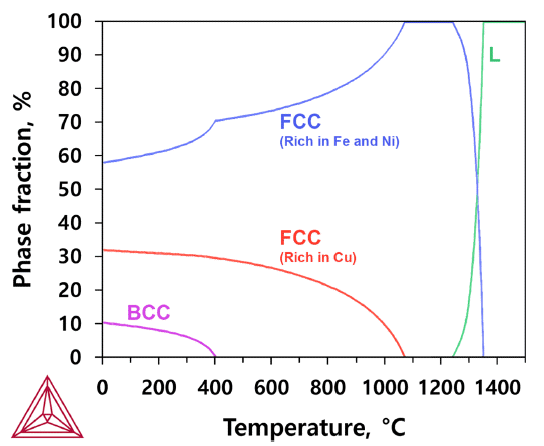
- 1,201 View
- 4 Download
- 2 Citations
-
 Abstract
Abstract
 PDF
PDF In this research, a new medium-entropy alloy with an equiatomic composition of FeCuNi was designed using a phase diagram (CALPHAD) technique. The FeCuNi MEA was produced from pure iron, copper, and nickel powders through mechanical alloying. The alloy powders were consolidated via a high-pressure torsion process to obtain a rigid bulk specimen. Subsequently, annealing treatment at different conditions was conducted on the four turn HPT-processed specimen. The microstructural analysis indicates that an ultrafine-grained microstructure is achieved after post-HPT annealing, and microstructural evolutions at various stages of processing were consistent with the thermodynamic calculations. The results indicate that the post-HPT-annealed microstructure consists of a dual-phase structure with two FCC phases: one rich in Cu and the other rich in Fe and Ni. The kernel average misorientation value decreases with the increase in the annealing time and temperature, indicating the recovery of HPT-induced dislocations.
-
Citations
Citations to this article as recorded by- High-pressure torsion of face-centered cubic multi-principal element alloys: Nanostructuring and its influence on properties
Avanish Kumar Chandan, Kaushal Kishore, Megumi Kawasaki, Terence G. Langdon, Jenő Gubicza
Progress in Materials Science.2025; : 101620. CrossRef - Effects of nickel content and annealing temperature on the magnetic characteristics of nanostructured FeCu alloys
Abderrahmane Younes
Journal of Materials Science: Materials in Electronics.2024;[Epub] CrossRef
- High-pressure torsion of face-centered cubic multi-principal element alloys: Nanostructuring and its influence on properties
- [English]
- Effects of Precipitates and Oxide Dispersion on the High-temperature Mechanical Properties of ODS Ni-Based Superalloys
- GooWon Noh, Young Do Kim, Kee-Ahn Lee, Hwi-Jun Kim
- J Korean Powder Metall Inst. 2020;27(1):8-13. Published online February 1, 2020
- DOI: https://doi.org/10.4150/KPMI.2020.27.1.8

- 1,544 View
- 30 Download
- 2 Citations
-
 Abstract
Abstract
 PDF
PDF In this study, we investigated the effects of precipitates and oxide dispersoids on the high-temperature mechanical properties of oxide dispersion-strengthened (ODS) Ni-based super alloys. Two ODS Ni-based super alloy rods with different chemical compositions were fabricated by high-energy milling and hot extrusion process at 1150 °C to investigate the effects of precipitates on high-temperature mechanical properties. Further, the MA6000N alloy is an improvement over the commercial MA6000 alloy, and the KS6000 alloy has the same chemical composition as the MA6000 alloy. The phase and microstructure of Ni-based super alloys were investigated by X-ray diffraction and scanning electron microscopy. It was found that MC carbide precipitates and oxide dispersoids in the ODS Ni-based super alloys developed in this study may effectively improve high-temperature hardness and creep resistance.
-
Citations
Citations to this article as recorded by- Mechanical Properties and Residual Stress Analysis of ODS Ni Superalloy Fabricated by Laser Powder Bed Fusion Process
Dong Wan Lee, Su Gwan Lee, Cong Dhin Van, Cae Ryeong Kim, Jin Chun Kim, Hwi Jun Kim, Joong Gyeong Lim, Tae Sik Yoon
Journal of the Japan Society of Powder and Powder Metallurgy.2025; 72(Supplement): S453. CrossRef - Additive manufacturing of oxide-dispersion strengthened alloys: Materials, synthesis and manufacturing
Markus B. Wilms, Silja-Katharina Rittinghaus, Mareen Goßling, Bilal Gökce
Progress in Materials Science.2023; 133: 101049. CrossRef
- Mechanical Properties and Residual Stress Analysis of ODS Ni Superalloy Fabricated by Laser Powder Bed Fusion Process
- [English]
- Spark Plasma Sintering of the Ni-graphite Composite Powder Prepared by Electrical Explosion of Wire in Liquid and Its Properties
- Minh Thuyet-Nguyena, Jin-Chun Kim
- J Korean Powder Metall Inst. 2020;27(1):14-24. Published online February 1, 2020
- DOI: https://doi.org/10.4150/KPMI.2020.27.1.14

- 794 View
- 2 Download
- 2 Citations
-
 Abstract
Abstract
 PDF
PDF In this work, the electrical explosion of wire in liquid and subsequent spark plasma sintering (SPS) was introduced for the fabrication of Ni-graphite nanocomposites. The fabricated composite exhibited good enhancements in mechanical properties, such as yield strength and hardness, but reduced the ductility in comparison with that of nickel. The as-synthesized Ni-graphite (5 vol.% graphite) nanocomposite exhibited a compressive yield strength of 275 MPa (about 1.6 times of SPS-processed monolithic nickel ~170 MPa) and elongation to failure ~22%. The hardness of Nigraphite composite had a value of 135.46 HV, which is about 1.3 times higher than that of pure SPS-processed Ni (105.675 HV). In terms of processing, this work demonstrated that this processing route is a novel, simple, and low-cost method for the synthesis of nickel-graphite composites.
-
Citations
Citations to this article as recorded by- Top-down strategies for achieving high-quality graphene: Recent advancements
Arpana Agrawal
Journal of Industrial and Engineering Chemistry.2025; 142: 103. CrossRef - Electrodeposition of nickel-titanium dioxide coatings and powders from aqueous sulfate solutions
Tazhibayeva Aigerim Shotaevna, Bayeshova Azhar Kospanovna, Bayeshov Abduali, Osińska Małgorzata
Polyhedron.2025; 277: 117571. CrossRef
- Top-down strategies for achieving high-quality graphene: Recent advancements
- [Korean]
- Thermophysical Properties of Copper/graphite Flake Composites by Electroless Plating and Spark Plasma Sintering
- Jaesung Lee, Ji Yeon Kang, Seulgi Kim, Chanhoe Jung, Dongju Lee
- J Korean Powder Metall Inst. 2020;27(1):25-30. Published online February 1, 2020
- DOI: https://doi.org/10.4150/KPMI.2020.27.1.25
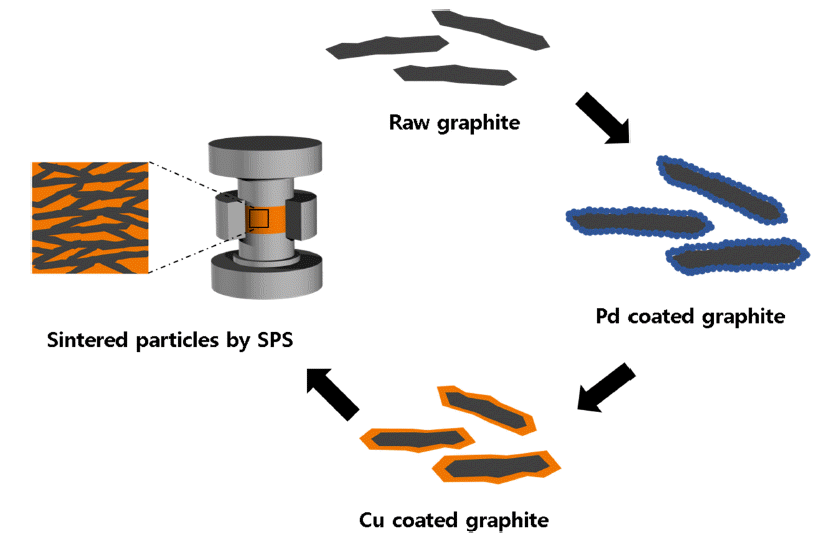
- 1,059 View
- 15 Download
-
 Abstract
Abstract
 PDF
PDF Recently, the amount of heat generated in devices has been increasing due to the miniaturization and high performance of electronic devices. Cu-graphite composites are emerging as a heat sink material, but its capability is limited due to the weak interface bonding between the two materials. To overcome these problems, Cu nanoparticles were deposited on a graphite flake surface by electroless plating to increase the interfacial bonds between Cu and graphite, and then composite materials were consolidated by spark plasma sintering. The Cu content was varied from 20 wt.% to 60 wt.% to investigate the effect of the graphite fraction and microstructure on thermal conductivity of the Cu-graphite composites. The highest thermal conductivity of 692 W m−1K−1 was achieved for the composite with 40 wt.% Cu. The measured coefficients of thermal expansion of the composites ranged from 5.36 × 10−6 to 3.06 × 10−6 K−1. We anticipate that the Cu-graphite composites have remarkable potential for heat dissipation applications in energy storage and electronics owing to their high thermal conductivity and low thermal expansion coefficient.
- [Korean]
- Effect of Phosphorus Addition on Microstructure and Mechanical Properties of Sintered Low Alloy Steel
- Yoo-Young Kim, Kwon-Koo Cho
- J Korean Powder Metall Inst. 2020;27(1):31-36. Published online February 1, 2020
- DOI: https://doi.org/10.4150/KPMI.2020.27.1.31
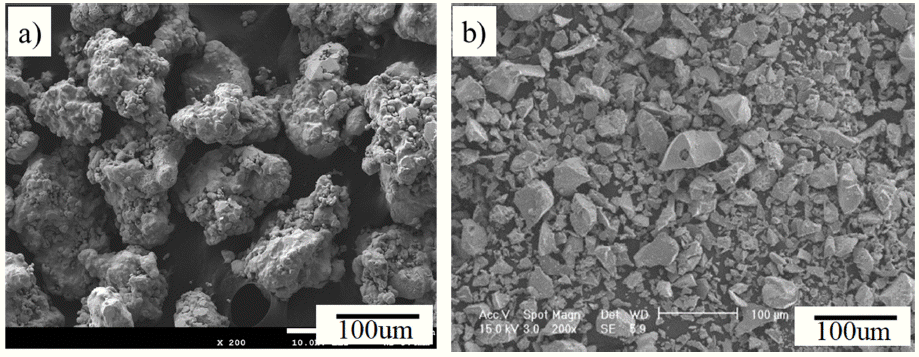
- 659 View
- 5 Download
- 1 Citations
-
 Abstract
Abstract
 PDF
PDF Phosphorus is an element that plays many important roles in powder metallurgy as an alloy element. The purpose of this study is to investigate the influence of phosphorus addition on the microstructures and mechanical properties of sintered low-alloy steel. The sintered low-alloy steels Fe-0.6%C-3.89%Ni-1.95%Cu-1.40%Mo-xP (x=0, 0.05, 0.10, 0.15, 0.20%) were manufactured by compacting at 700 MPa, sintering in H2-N2 at 1260 °C, rapid cooling, and low-temperature tempering in Ar at 160 °C. The microstructure, pore, density, hardness, and transverse rupture strength (TRS) of the sintered low-alloy steels were evaluated. The hardness increased as the phosphorus content increased, whereas the density and TRS showed maximum values when the content of P was 0.05%. Based on microstructure observation, the phase of the microstructure changed from bainite to martensite as the content of phosphorus is increased. Hence, the most appropriate addition of phosphorus in this study was 0.05%.
-
Citations
Citations to this article as recorded by- A new strategy for metal additive manufacturing using an economical water-atomized iron powder for laser powder bed fusion
Taehyeob Im, Kopila Gurung, Sebastian Meyers, Antonio Cutolo, Huengseok Oh, Jai-Sung Lee, Brecht Van Hooreweder, Caroline Sunyong Lee
Journal of Materials Processing Technology.2022; 308: 117705. CrossRef
- A new strategy for metal additive manufacturing using an economical water-atomized iron powder for laser powder bed fusion
- [Korean]
- Structural Characteristics, Microstructure and Mechanical Properties of Fe-Cr-Al Metallic Foam Fabricated by Powder Alloying Process
- Kyu-Sik Kim, Byeong-Hoon Kang, Man-Ho Park, Jung-Yeul Yun, Kee-Ahn Lee
- J Korean Powder Metall Inst. 2020;27(1):37-43. Published online February 1, 2020
- DOI: https://doi.org/10.4150/KPMI.2020.27.1.37
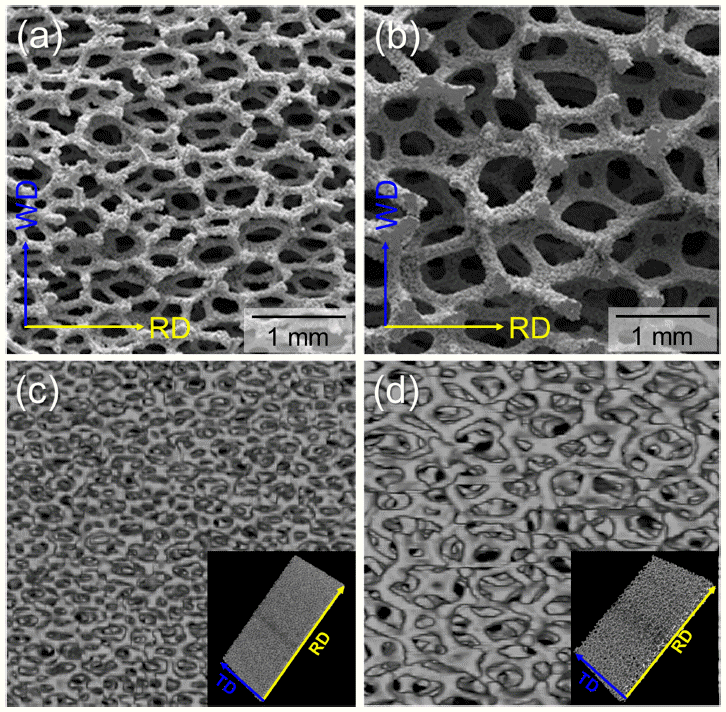
- 509 View
- 5 Download
-
 Abstract
Abstract
 PDF
PDF The Fe-22wt.%Cr-6wt.%Al foams were fabricated via the powder alloying process in this study. The structural characteristics, microstructure, and mechanical properties of Fe-Cr-Al foams with different average pore sizes were investigated. Result of the structural analysis shows that the average pore sizes were measured as 474 μm (450 foam) and 1220 μm (1200 foam). Regardless of the pore size, Fe-Cr-Al foams had a Weaire-Phelan bubble structure, and α-ferrite was the major constituent phase. Tensile and compressive tests were conducted with an initial strain rate of 10−3 /s. Tensile yield strengths were 3.4 MPa (450 foam) and 1.4 MPa (1200 foam). Note that the total elongation of 1200 foam was higher than that of 450 foam. Furthermore, their compressive yield strengths were 2.5 MPa (450 foam) and 1.1 MPa (1200 foam), respectively. Different compressive deformation behaviors according to the pore sizes of the Fe-Cr-Al foams were characterized: strain hardening for the 450 foam and constant flow stress after a slight stress drop for the 1200 foam. The effect of structural characteristics on the mechanical properties was also discussed.
- [Korean]
- Optimization of Metal Powder Particle Size Distribution for Powder Bed Fusion Process via Simulation
- Hwaseon Lee, Dae-Kyeom Kim, Young Il Kim, Jieun Nam, Yong Son, Taek-Soo Kim, Bin Lee
- J Korean Powder Metall Inst. 2020;27(1):44-51. Published online February 1, 2020
- DOI: https://doi.org/10.4150/KPMI.2020.27.1.44
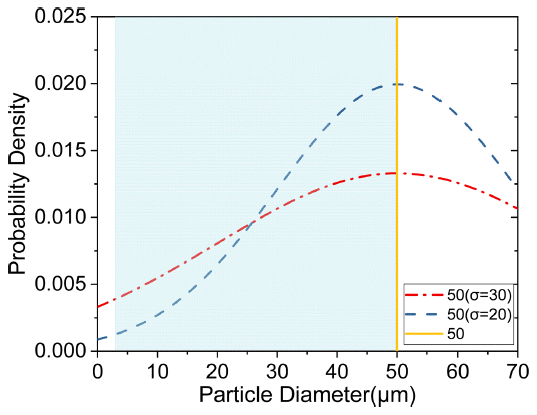
- 1,362 View
- 10 Download
- 1 Citations
-
 Abstract
Abstract
 PDF
PDF Powder characteristics, such as density, size, shape, thermal properties, and surface area, are of significant importance in the powder bed fusion (PBF) process. The powder required is exclusive for an efficient PBF process. In this study, the particle size distribution suitable for the powder bed fusion process was derived by modeling the PBF product using simulation software (GeoDict). The modeling was carried out by layering sintered powder with a large particle size distribution, with 50 μm being the largest particle size. The results of the simulation showed that the porosity decreased when the mean particle size of the powder was reduced or the standard deviation increased. The particle size distribution of prepared titanium powder by the atomization process was also studied. This study is expected to offer direction for studies related to powder production for additive manufacturing.
-
Citations
Citations to this article as recorded by- Review of “Integrated Computer-Aided Process Engineering Session in the International Symposium on Innovation in Materials Processing (ISIMP, 26–29 October 2021)”
Hyunjoo Choi, Jungjoon Kim, Pil-Ryung Cha, Hyoung Seop Kim
MATERIALS TRANSACTIONS.2023; 64(10): 2542. CrossRef
- Review of “Integrated Computer-Aided Process Engineering Session in the International Symposium on Innovation in Materials Processing (ISIMP, 26–29 October 2021)”
- [Korean]
- Effect of Milling Time on the Microstructure and Mechanical Properties of Ta20Nb20V20W20Ti20 High Entropy Alloy
- Da Hye Song, Yeong Gyeom Kim, Jin Kyu Lee
- J Korean Powder Metall Inst. 2020;27(1):52-57. Published online February 1, 2020
- DOI: https://doi.org/10.4150/KPMI.2020.27.1.52
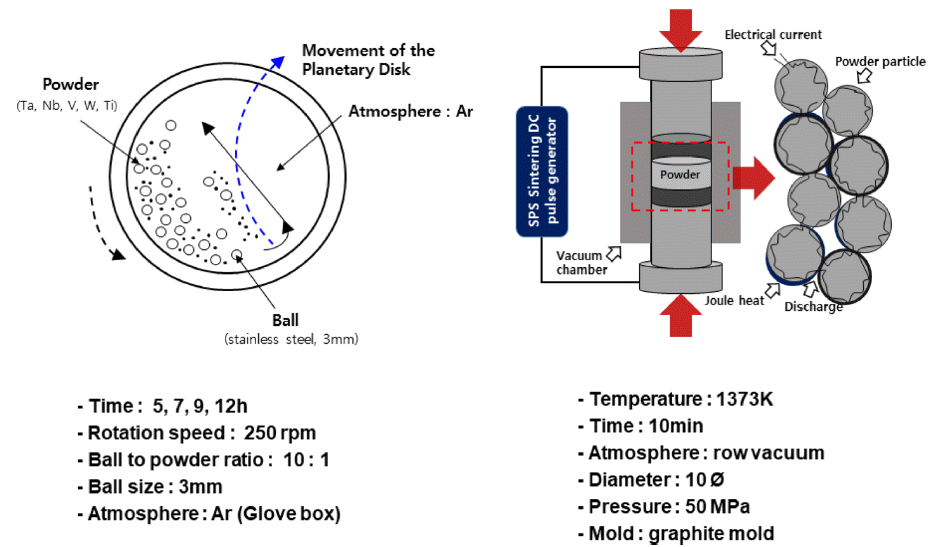
- 760 View
- 5 Download
-
 Abstract
Abstract
 PDF
PDF In this study, we report the microstructure and characterization of Ta20Nb20V20W20Ti20 high-entropy alloy powders and sintered samples. The effects of milling time on the microstructure and mechanical properties were investigated in detail. Microstructure and structural characterization were performed by scanning electron microscopy and X-ray diffraction. The mechanical properties of the sintered samples were analyzed through a compressive test at room temperature with a strain rate of 1 × 10−4 s−1. The microstructure of sintered Ta20Nb20V20W20Ti20 high-entropy alloy is composed of a BCC phase and a TiO phase. A better combination of compressive strength and strain was achieved by using prealloyed Ta20Nb20V20W20Ti20 powder with low oxygen content. The results suggest that the oxide formed during the sintering process affects the mechanical properties of Ta20Nb20V20W20Ti20 high-entropy alloys, which are related to the interfacial stability between the BCC matrix and TiO phase.
- [Korean]
- Viologen-based All-in-one Electrochromic Devices with a Lateral Electrode Structure
- Hyun-Jeong Kim, Sang-Rae Lee, Jin-Hee Choi, Yoon-Chae Nah
- J Korean Powder Metall Inst. 2020;27(1):58-62. Published online February 1, 2020
- DOI: https://doi.org/10.4150/KPMI.2020.27.1.58
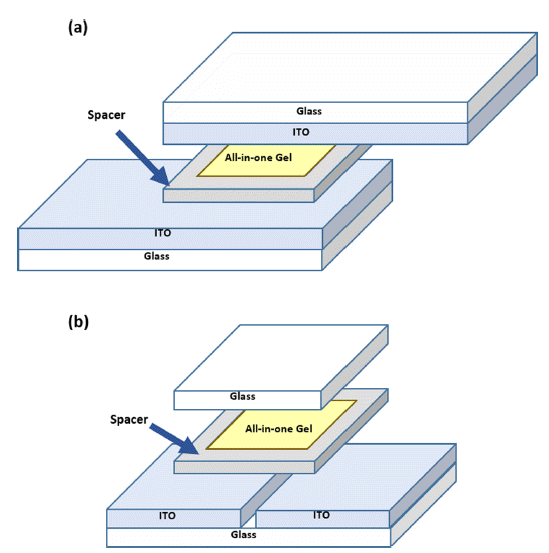
- 987 View
- 9 Download
- 1 Citations
-
 Abstract
Abstract
 PDF
PDF Recently, electrochromic devices (ECDs) have gathered increasing attention owing to their high color contrast and memory effect, which make them highly applicable to smart windows, auto-dimming mirrors, sensors, etc. Traditional ECDs have a sandwich structure that contains an electrochromic layer between two ITO substrates. These sandwich-type devices are usually fabricated through the lamination of two electrodes and followed by the injection of a liquid electrolyte in the inner space. However, this process is sometimes complex and time consuming. In this study, we fabricated ECDs with a lateral electrode structure that uses only an ITO substrate and an all-in-one electrochromic gel, which is a mixture of electrolyte and electrochromic material. Furthermore, we investigated the EC properties of the lateral-type device by comparing it with a sandwich-type device. The lateral-type ECD shows strong blue absorption as the applied voltage increases and has a competitive coloration efficiency compared to the sandwich-type device.
-
Citations
Citations to this article as recorded by- Viologens and extended viologen derivatives with mono- and di-hexyl substituents for highly stable all-in-one ECDs and solar cell powered large-area ECDs
Fangyuan Sun, He Zhang, Cong Wang, Huan Ling, Jiayi Cai, Weilun Peng, Yanhong Tian, Fengyu Su, Yanqing Tian, Yan Jun Liu
Materials Chemistry and Physics.2023; 301: 127593. CrossRef
- Viologens and extended viologen derivatives with mono- and di-hexyl substituents for highly stable all-in-one ECDs and solar cell powered large-area ECDs
- [Korean]
- Recent Research Progress on the Atomic Layer Deposition of Noble Metal Catalysts for Polymer Electrolyte Membrane Fuel Cell
- Jeong Hwan Han
- J Korean Powder Metall Inst. 2020;27(1):63-71. Published online February 1, 2020
- DOI: https://doi.org/10.4150/KPMI.2020.27.1.63
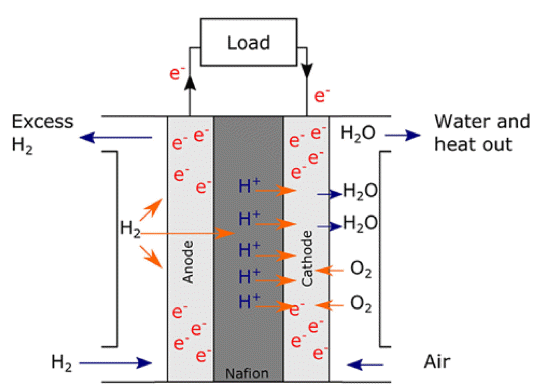
- 487 View
- 4 Download
-
 Abstract
Abstract
 PDF
PDF It is necessary to fabricate uniformly dispersed nanoscale catalyst materials with high activity and long-term stability for polymer electrolyte membrane fuel cells with excellent electrochemical characteristics of the oxygen reduction reaction and hydrogen oxidation reaction. Platinum is known as the best noble metal catalyst for polymer electrolyte membrane fuel cells because of its excellent catalytic activity. However, given that Pt is expensive, considerable efforts have been made to reduce the amount of Pt loading for both anode and cathode catalysts. Meanwhile, the atomic layer deposition (ALD) method shows excellent uniformity and precise particle size controllability over the three-dimensional structure. The research progress on noble metal ALD, such as Pt, Ru, Pd, and various metal alloys, is presented in this review. ALD technology enables the development of polymer electrolyte membrane fuel cells with excellent reactivity and durability.
TOP
 KPMI
KPMI




 First
First Prev
Prev


